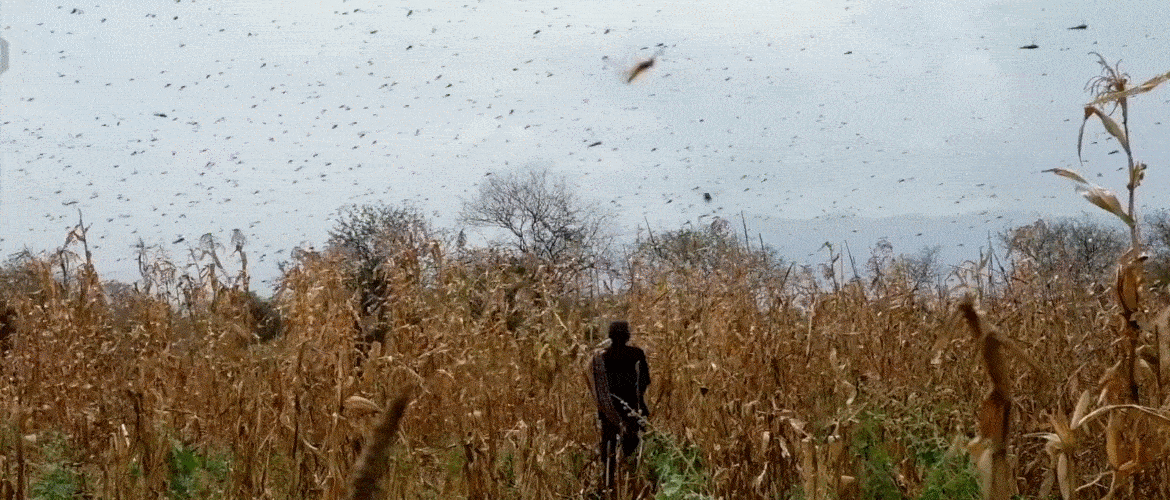The Locust Locomotion-Generational Foes
February 13, 2020 | Expert Insights

What are Locusts?
Locusts are as old as mankind, finding mention in Vedic literature and in the Bible.
In a solitary state with low population density, locusts are as harmless as the common grasshopper, however, with ideal bio-climatic conditions like – too much heat followed by high humidity- they multiply rapidly over time and space. They quickly form huge gregarious swarms that can travel 150 km in a day and consume up to 200 tons of crops per day. A super swarm can cut a swathe equal to 20% of the land surface of the earth.
The Looming Threat
As per the UN, an average swarm can devour food enough to feed 34 million people. FAO estimates that the current infestation puts at risk an estimated 19 million people in the food deficient region of East Africa.
The threat is clear and present. Within the next six months, the locusts are capable of increasing their numbers up to 400 times. Most of the breeding grounds of East Africa are in remote and isolated areas controlled by Al-Shabaab, a dreaded terrorist group. Ground-based teams cannot neutralise the locusts in the breeding stage itself before they get airborne.
Furthermore, with traditional grazing areas laid waste by passing swarms, the herding population in these countries will seek alternate pastures, raising the risk levels for internal and external conflict.
Ethiopia, Somalia, and Kenya are dealing with swarms of 'unprecedented size and destructive potential’ that could last till June. Egypt, Eritrea, Saudi Arabia, Sudan, and Yemen are also seeing substantial breeding activity. India has already suffered one invasion from Pakistan and Iran, with more predicted.
Climate Change-Contributing Factor
Climate change has a direct impact on locust breeding cycles. They normally breed in the semi-arid and arid deserts of Africa. These regions receive less than 200mm of rainfall every year. The last five years have been hotter than any other, since the industrial revolution. Unusually heavy rains followed by hot summers and unexpected cyclones off the Somalian coast created humid conditions that are ideal for breeding.
Breaking the Swarms
Swarms are destructive but once broken up are easily destroyed. They then become a favourite food of birds and animals and are considered a delicacy in some human societies too.
As per the UN, “given the scale of the current swarms, aerial control is the only effective means to reduce the locust numbers”. Land or aerial platforms spray insecticides like persistent organo-chlorines BHC (benzene hexachloride) and Dieldrin. However, there are environmental concerns as Dieldrin remains toxic for a 30-40-day period on vegetation and longer in soil. Ultra-low volume (ULV) formulations can minimise environmental impacts. However, best is environment-friendly biological control mechanisms, nurturing the growth of natural predators such as wasps, birds, and reptiles, etc.
Low flying planes generate atmospheric disturbances over transiting swarms to break them up or spray pesticides while they are feeding on the ground. However, the job gets harder as the swarms grow larger, making it extremely hazardous for small aircraft to fly through or near them.
Some management strategies have looked at creating exclusion zones, such as burning tyres, catching them in nets or by digging trenches. These measures could help prevent locusts from reaching a particular area, but does little to break up the swarm.
The FAO has provided Geographical positioning systems, installed with the RAMSES system, with GIS tools for quick data management and analysis. The FAO has also provided Satellite data imagery for planning desert locusts surveys according to the green vegetation availability. The FAO and the UN have appealed for 70 million dollars.
India Watch
Thanks to favourable wind conditions and some timely action, the locust damage in Gujarat and some parts of Rajasthan has been controlled with the help of pesticides and specialist equipment. Some innovative measures like playing the drums, clanging utensils, switching on table fans near crops and even blaring out music on truck-mounted loudspeakers proved effective. Aerial spraying was not possible as the swarms were over inhabited areas, and it could have affected livestock and human beings.
Indian Ministry of Agriculture has had a Locust Warning Organisation (LWO) since 1939 and also an effective locust control and research scheme. Surveillance systems, satellite imagery and information exchange between the state and the FAO have proved beneficial to combat the menace.
Assessment
Locust infestation is one big calamity that has been compounded by climate change. The unusually hot summers followed by rainfall which was 400% over normal was caused by the Indian Ocean dipole which is attenuated by climate change. Could there be a more compulsive reason than this to make the world come together and fight global warming as a priority one threat to mankind?
Acridologists have to be equipped with appropriate technology to detect the forming up of swarms and track them to predict their course. A structured geospatial database in the GIS environment has to be created which interacts with other analytical tools to create a decision support system for which again the global scientific community has to come together. While the richer western world may not be directly impacted, they have a responsibility for the larger good.
Early detection and destruction of breeding areas is the most cost-effective cure. India has considerable experience in this through its LWO and R&D establishment, and it could share this expertise with East African countries as part of its soft power outreach. Locust monitoring stations collect data on weather, ecological conditions and locust numbers, making forecasts of the timing and location of breeding.
Image Design:Chris Karedan, Synergia Foundation








Comments